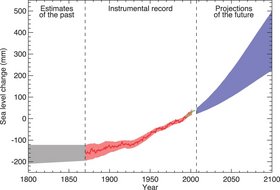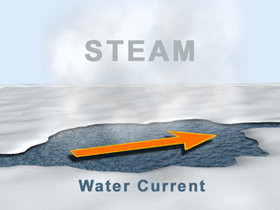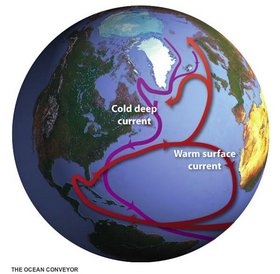Climate Solutions: Chapter 4
Contents
Ocean Thermal Energy Conversion
As seawater warms up, it expands, increasing the volume of the global ocean. [28] —Gerald Meehl and his IPCC colleagues, 2007
Global warming raises the potential of unlocking large amounts of fresh water now frozen in the vast Greenland ice sheet and in Arctic Ocean sea ice. Warming air temperatures could also increase evaporation in low latitudes and transport freshwater vapor toward high latitudes, where it falls as rain or snow into the oceans. Could these factors tip the freshwater balance in the North Atlantic in the future? [27]
—Jerry McManus and Delia Oppo, Woods Hole Oceanographic Institution, 2006
As we have learned, the ocean is a vast reservoir, not only of water, but also of heat. The thermal layers are not uniform. Surface water warmed by the sun tends to contain more heat than layers 100 meters below the surface or deeper. The bigger the temperature difference between the warmer top water and colder bottom water, the more potential exists to convert that difference into other kinds of energy, such as electricity. Ocean Thermal Energy Conversion (OTEC) is an energy technology that converts solar radiation to electric power. OTEC systems use the ocean's natural thermal gradient—the difference in temperatures of the ocean's layers of water—to drive a power-producing cycle. As long as the temperature between the warm surface water and the cold deep water differs by about 20°C (36°F), an OTEC system can produce a significant amount of power, with little impact on the surrounding environment. As the OTEC Web site notes, “The oceans are thus a vast renewable resource, with the potential to help us produce billions of watts of electric power.” [31] According to some experts, this potential may be as large as 10,000 billion watts of continuous baseload power generation.
Essentially, the technology involves pumping cold deep ocean water to the surface, exchanging the thermal energy between the two reservoirs in a heat engine, and returning the water to the mixed layer between the warm top and cold deep layers. Experimental OTEC stations have been in operation since the late 1990s. The by-products of the heat exchange include clean freshwater (which rivals in quality that of modern desalination plants) and cold "waste" water, which could be used for marine aquaculture or even for growing plants on land, as the Seawater Greenhouse project shows.*
- www.seawatergreenhouse.com
Online figures
Bibliography
- Arctic Climate Impact Assessment, Hassol SJ (2004) in Impacts of Arctic Warming: Arctic Climate Assessment Report. Arctic Council and the International Arctic Science Committee. http://www.acia.uaf.edu
- Bindoff NL, Willebrand J, Artale V, Cazenave A, Gregory J, Gulev S, Hanawa K, Le Quéré C, Levitus S, Nojiri Y, et al. (2007) Observations: Oceanic Climate Change and Sea Level (in Climate Change 2007: The Physical Science Basis. Contribution of Working Group I to the Fourth Assessment Report of the Intergovernmental Panel on Climate Change, eds Solomon S, Qin D, Manning M, Chen Z, Marquis M, Averyt KB, Tignor MH, Miller L) ar4-wg1-chapter5.pdf: http://www.ipcc.ch
- Bluhm B, Hopcroft R (2006) Arctic Biodiversity. Ocean Explorer. NOAA (read November 13, 2008). http://oceanexplorer.noaa.gov/explorations/05arctic/background/biodiversity/biodiversity.html
- Caldiera K, Kleypas J (2006) COMPASS Briefings “It’s Not Just the Heat, It’s the Acidity (Caldeira).” COMPASS 2006 (May 23)(read September 18, 2008). http://www.compassonline.org/meetings/briefings_hoc.asp
- Canadell JG, Le Quéré C, Raupach MR, Field CB, Buitenhuis ET, Ciais P, Conway TJ, Gillett NP, Houghton RA, Marland G (2007) Contributions to accelerating atmospheric CO2 growth from economic activity, carbon intensity, and efficiency of natural sinks. Proceedings of the National Academy of Sciences 104(47):18866. http://www.pnas.org/cgi/content/abstract/104/47/18866
- CIA (2007) The World Factbook. (Central Intelligence Agency, Washington, DC). http://www.cia.gov/library/publications/download/index.html
- Cook J (2005) “The Ocean Conveyor” in Illustration Gallery in Images & Multimedia. Oceanus Magazine. (Woods Hole Oceanographic Institution, Woods Hole, MA) (read November 17, 2008). http://www.whoi.edu/oceanus
- Dickson B, Yashayaev I, Meincke J, Turrell B, Dye S, Holfort J (2002) Rapid freshening of the deep North Atlantic Ocean over the past four decades. Nature 416 (April 25, 2002). http://www.nature.com/nature/journal/v416/n6883/abs/416832a.html
- Drought Monitor (2008) National Drought Mitigation Center. Lincoln, NE (read November 16, 2008). http://drought.unl.edu/dm/
- Fearnside P (2007) “Deforestation in Amazonia,” (topic ed) Hall-Beyer M, in Encyclopedia of Earth, (ed) Cleveland CJ. (Environmental Information Coalition, National Council for Science and the Environment, Washington, DC). [[1]]
- Fung IY, Doney SC, Lindsay K, John J (2005) Evolution of carbon sinks in a changing climate. Proceedings of the National Academy of Sciences 102(32):11201?– 11206. http://www.pnas.org/cgi/content/abstract/102/32/11201
- Gagosian RB (2003) Abrupt Climate Change: Should We Be Worried? World Economic Forum. Davos, Switzerland. http://www.whoi.edu/page.do?pid=12455&tid=282&cid=9986
- Gallessich G (2008) Climate Change Seen Turning Seas Acidic.931060 UCSB March 3, 2008. http://www.ia.ucsb.edu/93106/2008/March3/Climate.html
- Gallessich G (2008) “Sea Ice,” (topic ed) Duffy JE, in Encyclopedia of Earth, (ed) Cleveland, CJ. (Environmental Information Coalition, National Council for Science and the Environment, Washington, DC). [[2]]
- Gattuso JP, et al. (2007) “Ocean acidification,” in Encyclopedia of Earth, (ed) Cleveland, CJ. (Environmental Information Coalition, National Council for Science and the Environment, Washington, DC). [[3]]
- Global Carbon Project (2008) Carbon Reductions and Offsets, in Earth System Science Partnership Report No. 5, eds Coulter L, Canadell JG, Dhakal S. http://www.globalcarbonproject.org
- Hansen J, Sato M, Ruedy R, Lo K, Lea DW, Medina-Elizade M (2006) Global temperature change. Proceedings of the National Academy of Sciences 103(39):14288. http://www.pnas.org/cgi/content/abstract/103/39/14288
- Hebert P, et al. (2008) “Arctic Ocean,” (topic ed) Duffy JETE, in Encyclopedia of Earth, (ed) Cleveland CJ. Biodiversity Institute of Ontario. (Environmental Information Coalition, National Council for Science and the Environment, Washington DC). [[4]]
- James S (2008) Gwich’in Culture. Gwich’in Steering Committee (read November 15, 2008). http://www.gwichinsteeringcommittee.org/gwichinnation.html
- James S (2008) Plenary Presentation: Summarizing Global Change Science and the Likely Implications of Global Climate Change. National Conference on Science, Policy, and the Environment: Climate Science and Solutions. http://ncseonline.org/2008conference
- Kimbell G (2008) Forest Management and Climate Change Response. National Conference on Science, Policy, and the Environment. http://ncseonline.org/2008conference
- Kleypas JA, Feely RA, Fabry VJ, Langdon C, Sabine CL, Robbins LL (2006) Impacts of Ocean Acidification on Coral Reefs and Other Marine Calcifiers: A Guide for Future Research. Report of a workshop held April 18?– 20, 2005, St. Petersburg, FL, sponsored by NSF, NOAA, and the US Geological Survey. 88 pp (read November 1, 2008). http://www.isse.ucar.edu/florida
- Langdon C, Takahashi T, Sweeney C, Chipman D, Goddard J, Marubini F, Aceves H, Barnett H, Atkinson MJ (2000) Effect of calcium carbonate saturation state on the calcification rate of an experimental coral reef. Global Biogeochemical Cycles 14(2):639?– 654. http://www.ncoremiami.org/members/personnel/GBC2000.pdf&oi=ggp
- Le Quéré C, Rödenbeck C, Buitenhuis ET, Conway TJ, Langenfelds R, Gomez A, Labuschagne C, Ramonet M, Nakazawa T, Metzl N (2007) Saturation of the Southern Ocean CO2 sink due to recent climate change. Science 316(5832):1735. http://www.sciencemag.org/cgi/content/abstract/sci;316/5832/1735
- Leinen M (2008) Oceans: A Carbon Sink or Sinking Ecosystems? National Conference on Science, Policy, and the Environment: Climate Science and Solutions. http://ncseonline.org/2008conference/
- MacCracken MC, Moore F, Topping JC (2007) Sudden and Disruptive Climate Change: Exploring the Real Risks and How We Can Avoid Them. (Earthscan Publications). http://www.climate.org/publications/sudden-disruptive-climate-change.html
- McManus J, Oppo D (2006) “The Once and Future Circulation of the Ocean: Clues in Seafloor Sediments Link Ocean Shifts and Climate Changes.” Oceanus Magazine, November 16, 2006. http://www.whoi.edu/page.do?pid=12455&tid=282&cid=17906
- Meehl GA, Stocker TF, Collins WD, Friedlingstein P, Gaye AT, Gregory JM, Kitoh A, Knutti R, Murphy JM, Noda A, et al. (2007) Global Climate Projections (in Climate Change 2007: The Physical Science Basis. Contribution of Working Group I to the Fourth Assessment Report of the Intergovernmental Panel on Climate Change, eds Solomon S, Qin D, Manning M, Chen Z, Marquis M, Averyt KB, Tignor MH, Miller L) ar4-wg1-chapter10.pdf: http://www.ipcc.ch
- Nerem RS, Dorsi S, Willis JK, Chambers DP, Mitchum GT (2007) Satellite and In Situ Observations of Regional Sea Level Change: What Can They Tell Us about Future Changes? American Geophysical Union. http://www.agu.org/cgi-bin/wais?jj=G44A-01
- NSIDC (2008) Arctic Sea Ice Down to Second-Lowest Extent; Likely Record-Low Volume Arctic Sea Ice Extent during the 2008 Melt. National Snow and Ice Data Center. Images & Multimedia, Boulder, CO (read November 1, 2008). http://www.nsidc.org/pubs/notes/
- OTEC (2008) Ocean Thermal Energy Conversion (read November 31, 2008). http://www.otec.org
- Permanent Service for Mean Sea Level (PSMSL) (2008) Home Page. Proudman Oceanographic Laboratory, Liverpool, UK (read October 1, 2008). http://www.pol.ac.uk/psmsl
- Schmitt RW (1992) “Mysteries of Planetary Plumbing.” Oceanus Magazine 35(2):38?– 45. (Woods Hole Oceanographic Institution, Woods Hole, MA). http://www.whoi.edu/oceanus/;
- Segar D (2007) Introduction to Ocean Sciences. (W. W. Norton & Company, New York). http://www.wwnorton.com/college
- UN Oceans (2008) United Nations Atlas of the Oceans (read August 24, 2008). http://www.oceansatlas.org/cds_static/en/human_settlements_coast__en_1877_all_1.html
- UNEP (2008) “Ilulissat Icefjord, Denmark-Greenland,” (topic ed) McGinley M, in Encyclopedia of Earth, (ed) Cleveland CJ. (Environmental Information Coalition, National Council for Science and the Environment, Washington, DC). [[5]]
- USFS and BLM (2008) Coordinated Resource Offering Protocol (CROP). US Forest Service and Bureau of Land Management (read December 17, 2008). http://www.forestsandrangelands.gov/Woody_Biomass/supply/CROP/index.shtml
- Whilden K, Margaret Leinen M, Whaley D, Grant B (2007) Ocean Fertilization as an Effective Tool for Climate Change Mitigation. Greenhouse Gas Market Report 2007. http://www.climos.com/publication.php
- World Conservation Union (2006) “Forest Environmental Services,” in Encyclopedia of Earth, (ed) Cleveland CJ. (Environmental Information Coalition, National Council for Science and the Environment, Washington, DC) (read August 29, 2008). [[6]]
Online resources
- Deforestation in Amazonia
- Forest environmental services
- Land-use and land-cover change
- Marine carbonate chemistry
- Ocean
- Ocean acidification
- Plankton
- Sea ice in the Arctic
- Sea-level rise and coastal stability in the Arctic
- Arctic Climate Impact Assessment
- Communication Partnership for Science and the Sea
- Drought Monitor
- Gwich'in Steering Committee
- International Union for Conservation of Nature
- NASA Earth Observatory
- National Snow and Ice Data Center
- Ocean Thermal Energy Conversion
- Sea Level CCAR
- United Nations Atlas of the Oceans
- Woods Hole Oceanographic Institution
Action items
Action 18: Coastal Management and Climate Change
Action 19: Forest Management and Climate Change
Action 25: Ocean Fertilization for Carbon Sequestration
Instructor resources
(password required)
|
|




_18866-70%2c_Fig._1.jpg)
_18866-70%2c_Fig._2.jpg)